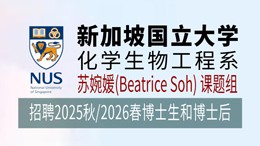当前位置:
X-MOL 学术
›
ACS Appl. Mater. Interfaces
›
论文详情
Our official English website, www.x-mol.net, welcomes your feedback! (Note: you will need to create a separate account there.)
Engineering the Kinetics of Directed Self-Assembly of Block Copolymers toward Fast and Defect-Free Assembly
ACS Applied Materials & Interfaces ( IF 8.3 ) Pub Date : 2018-06-07 00:00:00 , DOI: 10.1021/acsami.8b05247 Jiaxing Ren 1 , Chun Zhou 1 , Xuanxuan Chen 1 , Moshe Dolejsi 1 , Gordon S. W. Craig 1 , Paulina A. Rincon Delgadillo 2 , Tamar Segal-Peretz 3 , Paul F. Nealey 1, 4
ACS Applied Materials & Interfaces ( IF 8.3 ) Pub Date : 2018-06-07 00:00:00 , DOI: 10.1021/acsami.8b05247 Jiaxing Ren 1 , Chun Zhou 1 , Xuanxuan Chen 1 , Moshe Dolejsi 1 , Gordon S. W. Craig 1 , Paulina A. Rincon Delgadillo 2 , Tamar Segal-Peretz 3 , Paul F. Nealey 1, 4
Affiliation

|
Directed self-assembly (DSA) of block copolymers (BCPs) can achieve perfectly aligned structures at thermodynamic equilibrium, but the self-assembling morphology can become kinetically trapped in defective states. Understanding and optimizing the kinetic pathway toward domain alignment is crucial for enhancing process throughput and lowering defectivity to levels required for semiconductor manufacturing, but there is a dearth of experimental, three-dimensional studies of the kinetic pathways in DSA. Here, we combined arrested annealing and TEM tomography to probe the kinetics and structural evolution in the chemoepitaxy DSA of PS-b-PMMA with density multiplication. During the initial stages of annealing, BCP domains developed independently at first, with aligned structures at the template interface and randomly oriented domains at the top surface. As the grains coarsened, the assembly became cooperative throughout the film thickness, and a metastable stitch morphology was formed, representing a kinetic barrier. The stitch morphology had a three-dimensional structure consisting of both perpendicular and parallel lamellae. On the basis of the mechanistic information, we studied the effect of key design parameters on the kinetics and evolution of structures in DSA. Three types of structural evolutions were observed at different film thicknesses: (1) immediate alignment and fast assembly when thickness < L0 (L0 = BCP natural periodicity); (2) formation of stitch morphology for 1.25–1.45L0; (3) fingerprint formation when thickness >1.64L0. We found that the DSA kinetics can be significantly improved by avoiding the formation of the metastable stitch morphology. Increasing template topography also enhanced the kinetics by increasing the PMMA guiding surface area. A combination of 0.75L0 BCP thickness and 0.50L0 template topography achieved perfect alignment over 100 times faster than the baseline process. This research demonstrates that an improved understanding of the evolution of structures during DSA can significantly improve the DSA process.
中文翻译:

设计嵌段共聚物直接自组装的动力学,以实现快速无缺陷的组装
嵌段共聚物(BCP)的直接自组装(DSA)可以在热力学平衡下实现完美对齐的结构,但是自组装形态可以在动力学上陷入缺陷状态。了解和优化朝向域对准的动力学途径对于提高工艺产量并将缺陷率降低到半导体制造所需的水平至关重要,但是目前尚缺乏对DSA动力学途径进行实验性的三维研究。在这里,我们结合了逮捕退火和TEM断层扫描技术,以探讨PS- b的化学外延DSA的动力学和结构演变-具有密度乘法的PMMA。在退火的初始阶段,BCP域首先独立发展,在模板界面处具有对齐的结构,在顶部表面处具有随机取向的域。随着晶粒的粗化,组件在整个膜厚度上变得协同工作,并形成了亚稳态的针脚形态,代表了动态屏障。针脚形态具有由垂直和平行薄片组成的三维结构。基于机理信息,我们研究了关键设计参数对DSA中结构动力学和演化的影响。在不同的膜厚度下观察到三种类型的结构演变:(1)当厚度< L 0(L0 = BCP自然周期);(2)1.25–1.45 L 0的线迹形态的形成;(3)形成指纹时厚度> 1.64大号0。我们发现,通过避免亚稳针迹形态的形成,可以显着改善DSA动力学。模板形貌的增加还通过增加PMMA引导表面积来增强动力学。0.75 L 0 BCP厚度和0.50 L 0模板形貌的组合比基线工艺快100倍以上,实现了完美的对齐。这项研究表明,对DSA过程中结构演变的更好理解可以显着改善DSA过程。
更新日期:2018-06-07
中文翻译:

设计嵌段共聚物直接自组装的动力学,以实现快速无缺陷的组装
嵌段共聚物(BCP)的直接自组装(DSA)可以在热力学平衡下实现完美对齐的结构,但是自组装形态可以在动力学上陷入缺陷状态。了解和优化朝向域对准的动力学途径对于提高工艺产量并将缺陷率降低到半导体制造所需的水平至关重要,但是目前尚缺乏对DSA动力学途径进行实验性的三维研究。在这里,我们结合了逮捕退火和TEM断层扫描技术,以探讨PS- b的化学外延DSA的动力学和结构演变-具有密度乘法的PMMA。在退火的初始阶段,BCP域首先独立发展,在模板界面处具有对齐的结构,在顶部表面处具有随机取向的域。随着晶粒的粗化,组件在整个膜厚度上变得协同工作,并形成了亚稳态的针脚形态,代表了动态屏障。针脚形态具有由垂直和平行薄片组成的三维结构。基于机理信息,我们研究了关键设计参数对DSA中结构动力学和演化的影响。在不同的膜厚度下观察到三种类型的结构演变:(1)当厚度< L 0(L0 = BCP自然周期);(2)1.25–1.45 L 0的线迹形态的形成;(3)形成指纹时厚度> 1.64大号0。我们发现,通过避免亚稳针迹形态的形成,可以显着改善DSA动力学。模板形貌的增加还通过增加PMMA引导表面积来增强动力学。0.75 L 0 BCP厚度和0.50 L 0模板形貌的组合比基线工艺快100倍以上,实现了完美的对齐。这项研究表明,对DSA过程中结构演变的更好理解可以显着改善DSA过程。















































 京公网安备 11010802027423号
京公网安备 11010802027423号